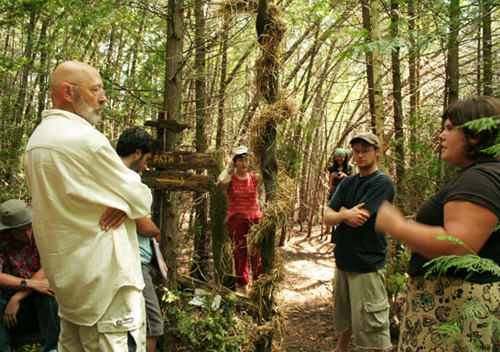
Within the dense forest, paths twist and turn. As you walk between the trees, you discover copper pipes of varying lengths suspended from the branches. To get past, you must nudge the pipes out of the way and they inevitably bang against each other, creating a unique kind of music.
“It is like playing a musical instrument from the inside as you push your way through it,” says U of G theatre studies Prof. Jerrard Smith.
This path through the woods – about five km long – and the many installations and constructions along the route are, Smith explains, the components of a theatre experience he calls Asterion. It’s certainly a theatre quite different from traditional expectations, and that’s part of the appeal to Smith. “I am interested in exploring site-specific work and creative spaces,” he says.
The location is a secret – for now. Smith has been working on this project, which is part of a cycle of music dramas called Patria begun by Canadian composer R. Murray Schafer in 2004. Smith has worked with Schafer on related projects since 1980. In 2006 the Guelph professor received funding that enabled him to build in the forest for three summers; he had no funding last year, but a new grant from the Social Sciences and Humanities Research Council will allow Smith to complete the project in 2014. The work is also supported by the University of Guelph and several corporate and individual art lovers.
“Basically we are building a labyrinth with about 50 spaces and transitional areas within the labyrinth,” he explains. “When it is done, people will go through one at a time, and as they walk through, they’ll encounter occasional live performances and the various installations that will engage their senses. With clues provided by us, a story will unfold. The experience will probably take a couple of hours for each person.” Part of the challenge once Asterion opens will be to keep visitors properly spaced and prevent bottlenecks within the labyrinth.
The story that will unfold as participants explore the various installations and experiences is a version of the myth of Theseus and Ariadne. “These characters reappear in the Patria Cycle in various forms,” says Smith. “Ariadne appears here as a voice, and Theseus is the animal spirit trying to get through the labyrinth and kill the Minotaur.”
And the Minotaur? “The Minotaur is you, the person walking through the labyrinth,” explains Smith. “It is your dark side. You will develop your own narrative and find your own Minotaur based on the way you interact with the space.” Asterion is another mythological name for the Minotaur.
Once the theatre/labyrinth is completed, it will be open for performances on specified days over the summer. People will need to apply to take part because the numbers will be very limited.
For Smith, one of the exciting parts of this project is working with students and other volunteers. About 40 students and a similar number of volunteers have worked on it each summer, including this one; Smith has also hired a dozen professional consultants and artists to contribute to the project. “I’ve commissioned artists in various disciplines to create installations or embellish the spaces,” he says.
The involvement of students and volunteers can also be challenging at times, he admits. “Students are not necessarily trained in the physical skills needed for this kind of work. We built a little labyrinth of tunnels out of straw bales and mortar, and they are really not in good shape now because they were not done professionally.”
There have also been some happy surprises: a dome created from chicken wire and cement turned out ─ quite by accident ─ to have great natural acoustics. “When the dome was finished, we went in and started humming, and at one point the room began to resonate. It’s a wonderful space,” says Smith.
He says it’s the process of discovery that attracts him to the project. “I’m interested in pulling the stories out of the spaces here and exploring them. We are trying to open people up to their senses, to have them listen to sound instead of ignoring noises around them. In one section, people will take off their shoes and walk over various textures such as sand, stones and moss. We want to make them more aware of the world.”
The progress of the project is documented on the www.patria.org website.
In addition to this ongoing work, Smith and his wife, Diana, a costume designer, are preparing an exhibit of their theatrical design work. “The focus of the exhibition will be the process of design from script through rough sketches to final drawings and completed pieces,” he says. “The physical works ─ masks, costumes, puppets and set pieces ─ will be featured prominently with the designs, photos, video clips and drawings providing secondary information to the visitor.”
The exhibit opens July 16 at the Clarington Museum and Archives in Bowmanville, Ont., and moves later to a gallery in Cambridge. Smith is well-known for his work on masks, costumes and theatre sets and has done design work for many productions and organizations, including the Canadian Opera Company and the National Ballet of Canada.